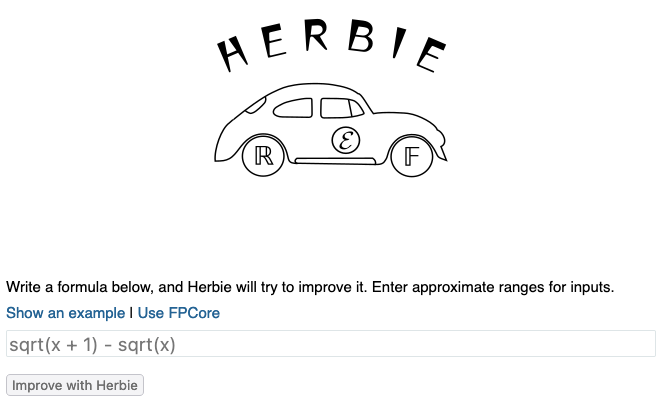The Browser UI


Herbie rewrites floating point expressions to make them more accurate. Herbie can be used from the command-line or from the browser; this page is about using Herbie from the browser.
The Herbie web shell lets you interact with Herbie through your browser, featuring a convenient input format. The web shell is the friendliest and easiest way to use Herbie.
Start the Herbie web shell by running:
racket -l herbie web
After a few seconds, the web shell will start up and direct your browser to Herbie:
racket -l herbie web Starting Herbie 2.2 with seed 1003430182 Your Web application is running at http://localhost:8000/. Stop this program at any time to terminate the Web Server.

You can type an input expressions in standard mathematical syntax. After typing in an expression, you will be asked to specify the range of values for each input variable. Once you're done, hit the "Improve with Herbie" button to run Herbie.
The web shell reports Herbie's progress and redirects to a report once Herbie is done.
The web shell can also automatically save the generated reports, and has many other options you might want to explore.
A report can also be generated directly from an input file in FPCore format:
racket -l herbie report bench/tutorial.fpcore output/ Starting Herbie 2.2 with seed 770126425... Warning: 25.0% of points produce a very large (infinite) output. You may want to add a precondition. See <https://herbie.uwplse.org/doc/latest/faq.html#inf-points> for more. 1/3 [ 0.8s] 55% → 100% Expanding a square 2/3 [ 0.8s] 100% → 100% Commute and associate 3/3 [ 0.9s] 53% → 100% Cancel like terms
This command generates a report from the input expressions
in bench/tutorial.fpcore and saves the report in the
directory output/. It's best if that directory doesn't
exist before running this command, because otherwise Herbie may
overwrite files in that directory.
Occasionally Herbie will emit warnings, just like in the example above. All of Herbie's warnings are documented, with explanations and suggested fixes.
The report Herbie generates is in HTML format so you'll need to start a web server. If you have Python installed, that's particularly convenient:
python3 -m http.server -d output
Then go to localhost:8000 in your favorite browser. The report summarizes Herbie's results for all expression in your input file, and you can click on individual expressions to see Herbie's output for them.
Batch report generation is the best way to run Herbie on a large collection of inputs. Like the web shell, it can be customized through command-line options, including parallelizing Herbie with multiple threads.